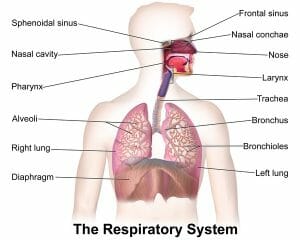Gas exchange in the lungs is one obvious way that the respiratory system helps maintain homeostasis. However, the respiratory system has several other strategies that keep the body in equilibrium.
Mechanical Functions to Maintain Homeostasis
The mouth and nose are the first lines of defense against invaders trying to enter via the respiratory system. Coughing and sneezing are important for expelling mucus and clearing the airways. Mucus traps bacteria, viruses, and dust before they progress further into the body. Also, tiny hairs in the nose and trachea have a thin coating of mucus to catch and hold particulates until they are expelled. The lungs also have vessels containing a fibrinolytic system that dissolves clots that try to pass through.
Gas Exchange
One of the main homeostatic functions of the respiratory system is the gas exchange that occurs in the alveoli in the lungs. As blood passes through the tiny capillaries in the alveolar sacs, changing pressure gradients allow oxygen and carbon dioxide to diffuse in and out of the blood.
Gas exchange in the lungs also helps maintain acid-base balance in the body. If the pH of the blood becomes too acidic, the breathing rate increases. This reduces the amount of carbon dioxide in the blood so the pH increases toward normal. Blood that is too alkaline will trigger slowing of the breathing to increase the amount of carbon dioxide (and thus, carbonic acid) and lower the pH.
Ventilation, or breathing, is controlled by the sympathetic and parasympathetic portions of the autonomic nervous system. The sympathetic nervous system causes bronchodilation like what happens during exercise. Conversely, parasympathetic stimulation results in bronchoconstriction. Coughing and sneezing are also under the control of the autonomic nervous system.
Temperature Regulation
In humans, one way the body dissipates excess heat to maintain homeostasis is through exhalation. Air that enters the lungs is warmed by body heat and then exhaled. This coupled with the evaporation of sweat from sweat glands cools the body. Animals like cats and dogs do not have sweat glands, so their method for cooling is rapid in and out breathing called panting.
Immunity
The lungs secrete an antibody known as IgA and cytokines like interleukin 25 (IL-25) and interleukin 33 (IL-33) to destroy invaders. Lymphoid tissue lines the respiratory system and it produces white blood cells such as lymphocytes that are ready to recognize and deactivate microbes entering the lungs. Cells called alveolar macrophages make up the largest population of immune cells in the lungs.

The image above shows the major features of the human respiratory system.
References
- OpenStax College. (2018). Anatomy & Physiology. Houston, TX. OpenStax CNX. Retrieved from http://cnx.org/contents/14fb4ad7-39a1-4eee-ab6e-3ef2482e3e22@8.119
- Respiratory System. (n.d.). In Wikipedia. Retrieved April 13, 2018 from https://en.wikipedia.org/wiki/Respiratory_system
How Does the Respiratory System Maintain Homeostasis
No comments:
Post a Comment